Analysis of the Stability of a High Fill Slope under Different Gradients and Precipitation Conditions
Abstract
:1. Introduction
2. Slope Geological Model
2.1. Basic Geological Overview
2.2. Types of Slope Instabilities
3. Study of the Physical and Mechanical Parameters of Backfill Soil
3.1. Determination of the Physico-Mechanical Parameters of Backfill Soil
3.2. Indoor Triaxial Test
3.2.1. Sample Preparation and Scheme Setting
3.2.2. Analysis of the Experimental Results
3.3. Determination of the Numerical Analysis Parameters of the Backfill Slope
4. Stability Analysis of the High Fill Slope
4.1. Slope Stability Analysis Based on the Rigid Body Limit Balance Method
4.2. Overall Stability Analysis of the Slope
4.3. Analysis of the Numerical Calculation Results of the Saturation State of the Backfill Slope
4.3.1. The Sensitivity Analysis of Soil Body Parameters
4.3.2. Mechanical Analysis of the Slope Sliding Surface
4.4. Numerical Simulation Analysis of High Fill Slope Stability with Different Slope Rates
4.4.1. Establishment of Slope Model and Setting of Boundary Conditions
4.4.2. Parameter Setting of the Numerical Model
4.4.3. Setting of the Rainfall Duration Curve under the Maximum Daily Rainfall
4.5. Slope Stability Analysis of Different Slope Rates under the Maximum Daily Rainfall Condition
5. Discussion
6. Limitations
7. Conclusions
- (1)
- The influence of water content on stress–strain curves is primarily manifested in the curve shape and the magnitude of the deviator stress peak. Under identical confining pressure, an increase in water content leads to an overall decrease in the stress–strain curve, along with a reduction in the magnitude of the deviator stress peak. Following the attainment of this peak, the curve gradually descends until it becomes flat. Changes in confining pressure result in noticeable alterations to the curve shape at different water contents, indicating that the impact of water content on curve shape is constrained by confining pressure.
- (2)
- With the rise of the water content, both the internal friction angle and cohesion of the soil diminish. However, the magnitudes of their being affected by the water content of the soil vary. When the water content increases from 18% to 19%, the internal friction angle drops from 36.05° to 32.88°, a decrease of 3.17°, with a reduction amplitude of 9%. The cohesion reduces from 89.66 kPa to 63.21 kPa, a decrease of 26.45 kPa, with a reduction amplitude of 29.5%. The aforementioned data suggest that the influence of the water content of the soil on cohesion is significantly greater than that on the internal friction angle. Additionally, the shear strength value of the soil decreases as the water content increases. Moreover, the greater the confining pressure, the higher the shear strength value. At the same time, the greater the confining pressure, the more pronounced the decreasing trend of the shear strength value of the soil.
- (3)
- The rigid limit equilibrium analysis indicates that the overall slope stability is satisfactory, with the stability coefficients all exceeding 1.30; the local stability calculation results reveal that the central slope in saturated working conditions exhibits a significantly higher stability coefficient of over 1.35.
- (4)
- The safety coefficients of high fill slopes with slope angles of 30°, 40°, and 50° under a maximum daily rainfall of 220 mm are determined to be 1.318, 1.025, and 0.950, respectively. With the increase in slope angle, there is a corresponding decrease in the safety coefficient by 22.2% and 7.3%. The slope with a 30° angle meets the evaluation requirements for stability and remains in a fundamentally stable state.
- (5)
- Comprehensive assessment of slope stability indicates overall favorable conditions. On-site investigation suggests that surface and shallow-layer instability may be the primary factors contributing to slope instability. It is advisable to implement measures for slope protection.
Author Contributions
Funding
Institutional Review Board Statement
Informed Consent Statement
Data Availability Statement
Conflicts of Interest
References
- Bao, H.; Liu, L.; Lan, H.; Peng, J.; Yan, C.; Tang, M.; Guo, G.; Zheng, H. Evolution of High-Filling Loess Slope under Long-Term Seasonal Fluctuation of Groundwater. Catena 2024, 238, 107898. [Google Scholar] [CrossRef]
- Yang, Z.; Cheng, X. High Fill Slope Collapse: Stability Evaluation Based on Finite Element Limit Analyses. Transp. Geotech. 2024, 44, 101156. [Google Scholar] [CrossRef]
- Mei, Y.; Zhou, D.; Hu, C.; Wang, X.; Zhang, Y.; Xiao, N.; Shi, W. Study on Deformation Characteristics of Loess Ultrahigh-Fill Slope Based on Large-Scale Undisturbed Soil Centrifugal Model Tests. Front. Earth Sci. 2022, 10, 848542. [Google Scholar] [CrossRef]
- Park, I.; Kang, C.; Bayat, A. Determination of Geotechnical Parameters for Underground Trenchless Construction Design. Bull. Eng. Geol. Environ. 2023, 82, 9. [Google Scholar] [CrossRef]
- Sun, K.; Zhang, L.; Jiang, G.; Yang, K.; Xiao, S. Stability Analysis of High Fill Slope of Laolinchangin Wushan County, Three Gorges Reservoir Area. J. China Three Gorges Univ. (Atural Sci.) 2024, 1–8. [Google Scholar]
- Zhu, Y.; Zhuang, J.; Zhao, Y. Failure Process of High-Loess-Filled-Slopes (HLFSs) during Precipitation under Different Mitigation Measures. Appl. Sci. 2024, 14, 419. [Google Scholar] [CrossRef]
- Zhang, Z.; Sheng, Q.; Song, D.; Fu, X.; Zhou, Y.; Huang, J. Stability Evaluation of the High Fill Deposit Slope Subjected to Rainfall Considering Water Deterioration. Bull. Eng. Geol. Environ. 2023, 82, 68. [Google Scholar] [CrossRef]
- Zhao, S.; Zheng, J.; Yang, J. Stability Analysis of Embankment Slope Considering Water Absorption and Softening of Subgrade Expansive Soil. Water 2022, 14, 3528. [Google Scholar] [CrossRef]
- Dai, X.; Zhang, J. Comparative Study on Analysis Methods of Slope Stability At a Certain Site. J. Saf. Sci. Technol. 2021, 17, 119–124. [Google Scholar]
- He, L.; Qian, J.; Zhao, C.; Li, Z. Study on Stability Analysis Method of High Fill Slope of Wushan Shennv Peak Airport. J. Hefei Univ. Technol. (Nat. Sci.) 2023, 46, 646–651, 703. [Google Scholar]
- Zhou, Y.-G.; Meng, D.; Ma, Q.; Huang, B.; Ling, D.-S.; Chen, Y.-M. Centrifuge Modeling of Dynamic Response of High Fill Slope by Using Generalized Scaling Law. Eng. Geol. 2019, 260, 105213. [Google Scholar] [CrossRef]
- GB 50021-2001; Ministry of Housing and Urban-Rural Development of the People’s Republic of China. Code for Investigation of Geotechnical Engineering. China Architecture Building Press: Beijing, China, 2009.
- GB 50330-2013; Ministry of Housing and Urban-Rural Development of the People’s Republic of China. Technical Code for Building Slope Engineering. China Architecture Building Press: Beijing, China, 2014.
- JTG 3430-2020; Ministry of Transport of the People’s Republic of China. Test Methods of Soils for Highway Engineering. China Communications Press: Beijing, China, 2021.
- Liu, W.; Yang, N.; Bai, F.; Chang, P. Parameter optimizationof covariance-driven stochastic subspace identification methodbased on sensitivity analysis. Eng. Mech. 2021, 38, 157. [Google Scholar]
- Dou, H.-Q.; Xie, S.; Wang, H.; Jane, W.-B. Numerical analysis of seepage characteristics and stability for spheroidal weathered granite-like soil slopes under rainfall conditions. J. Eng. Geol. 2023, 3, 638–649. [Google Scholar] [CrossRef]

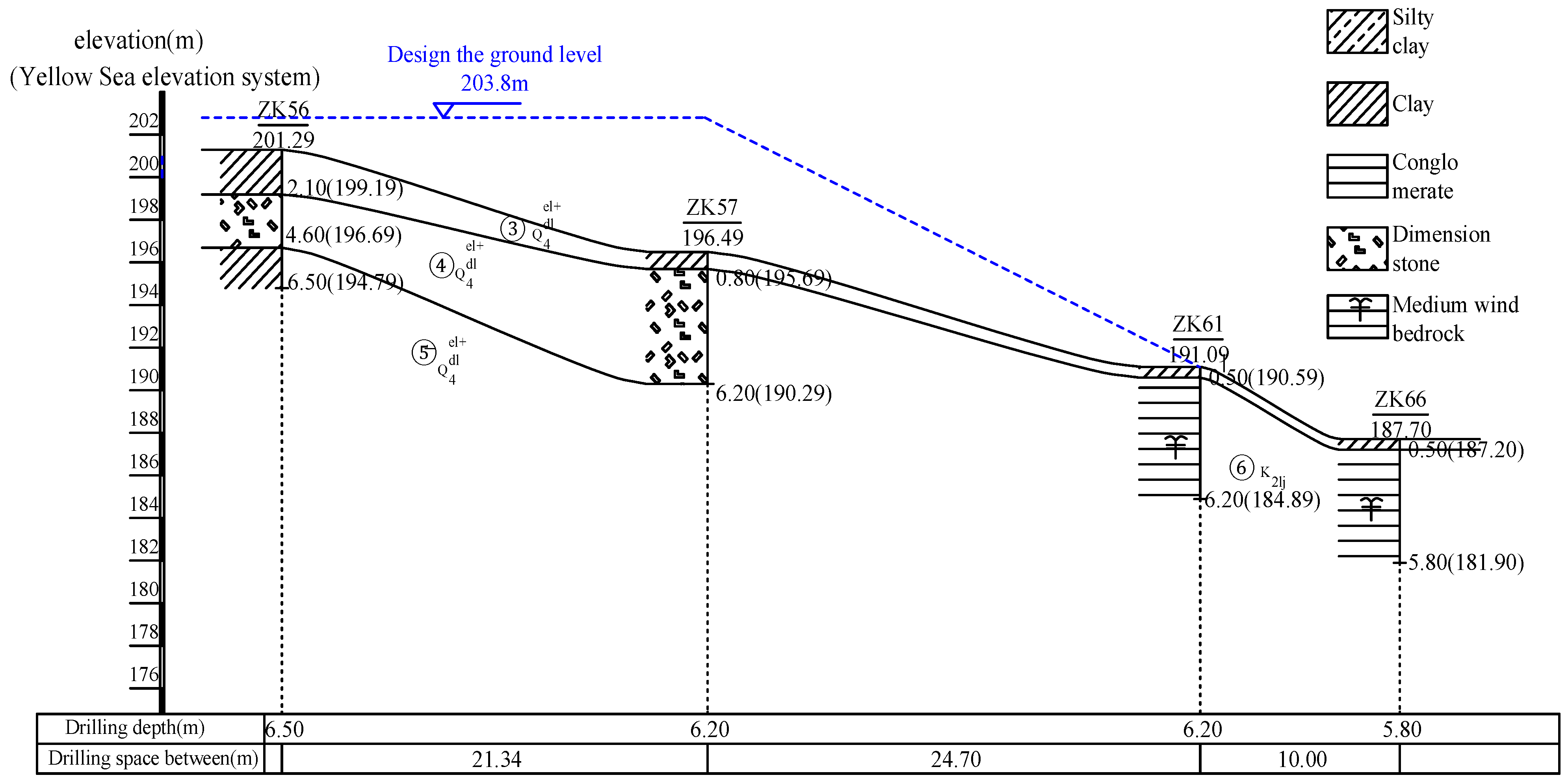



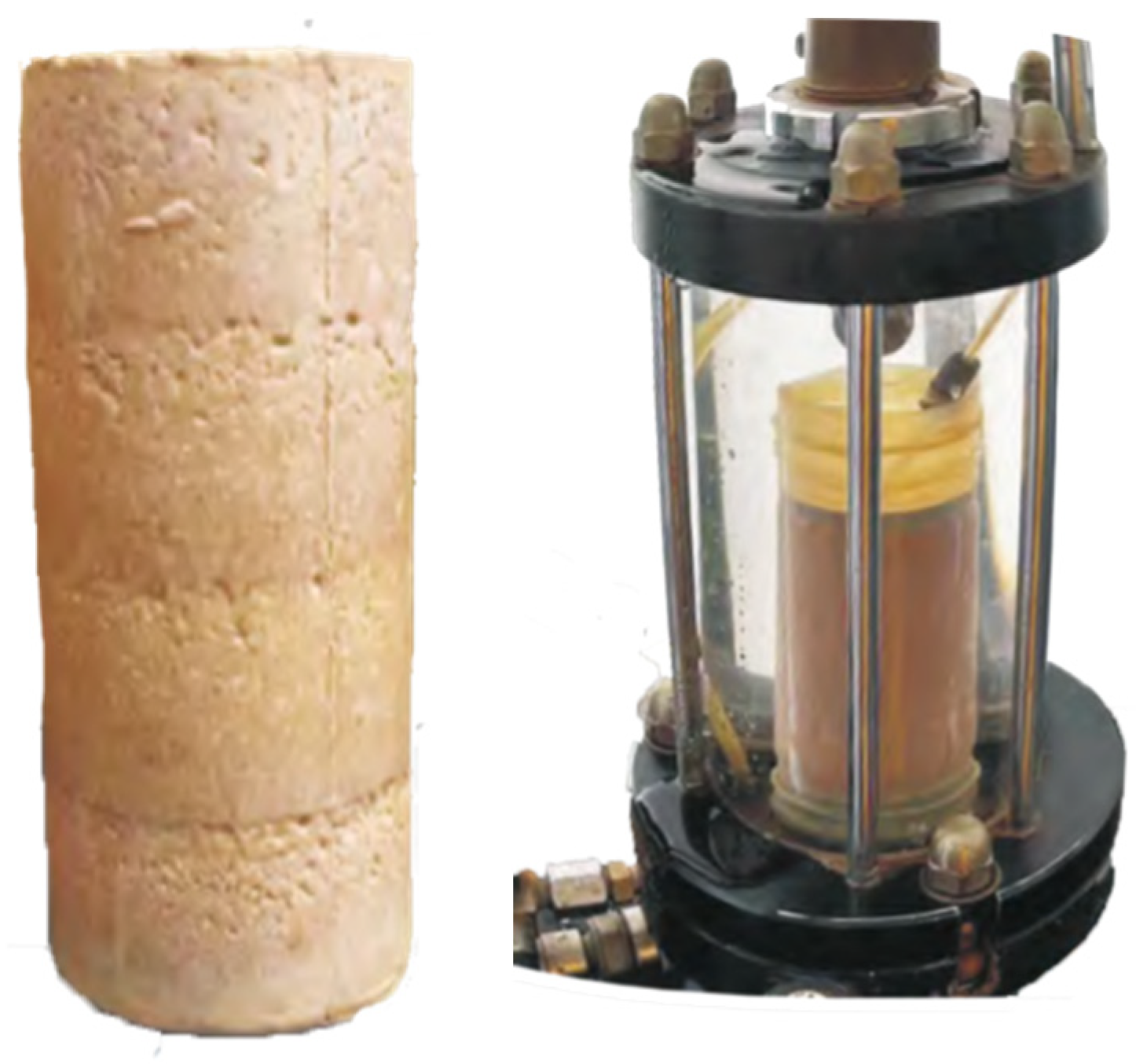

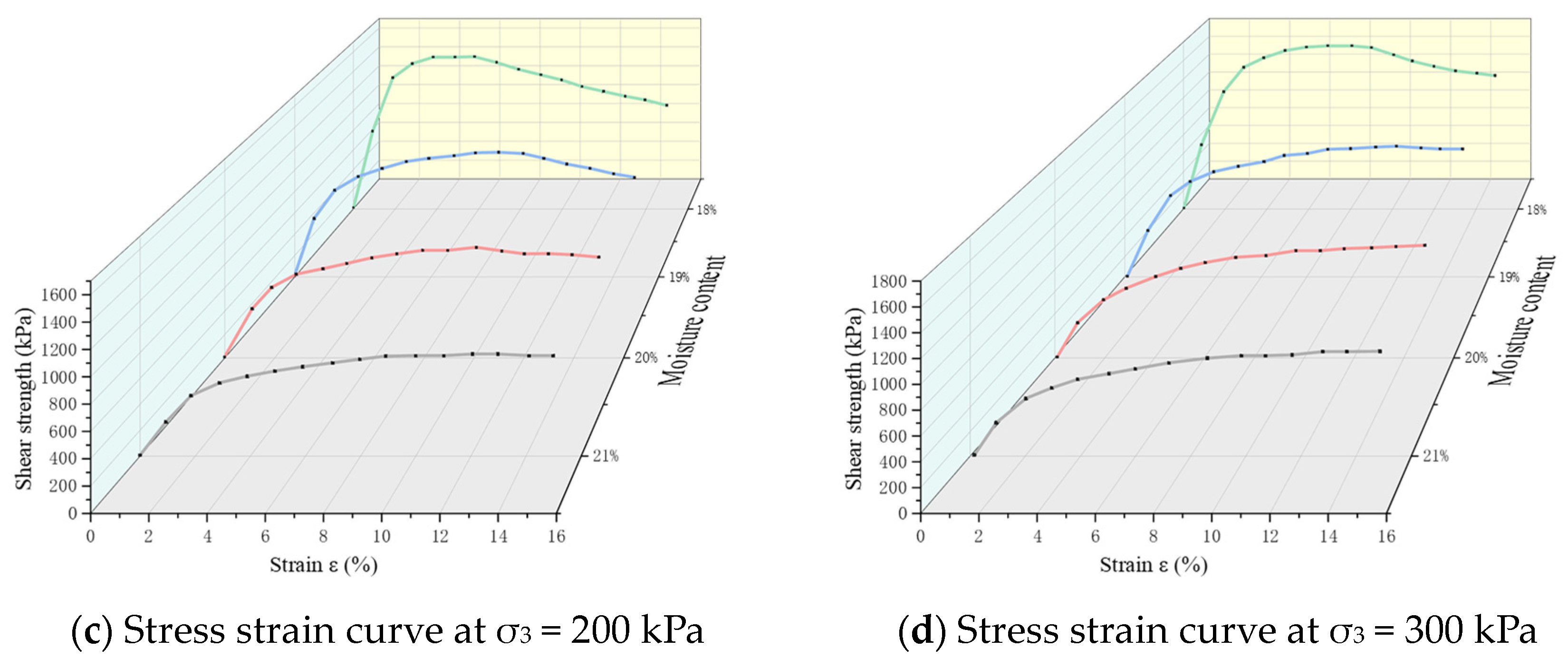

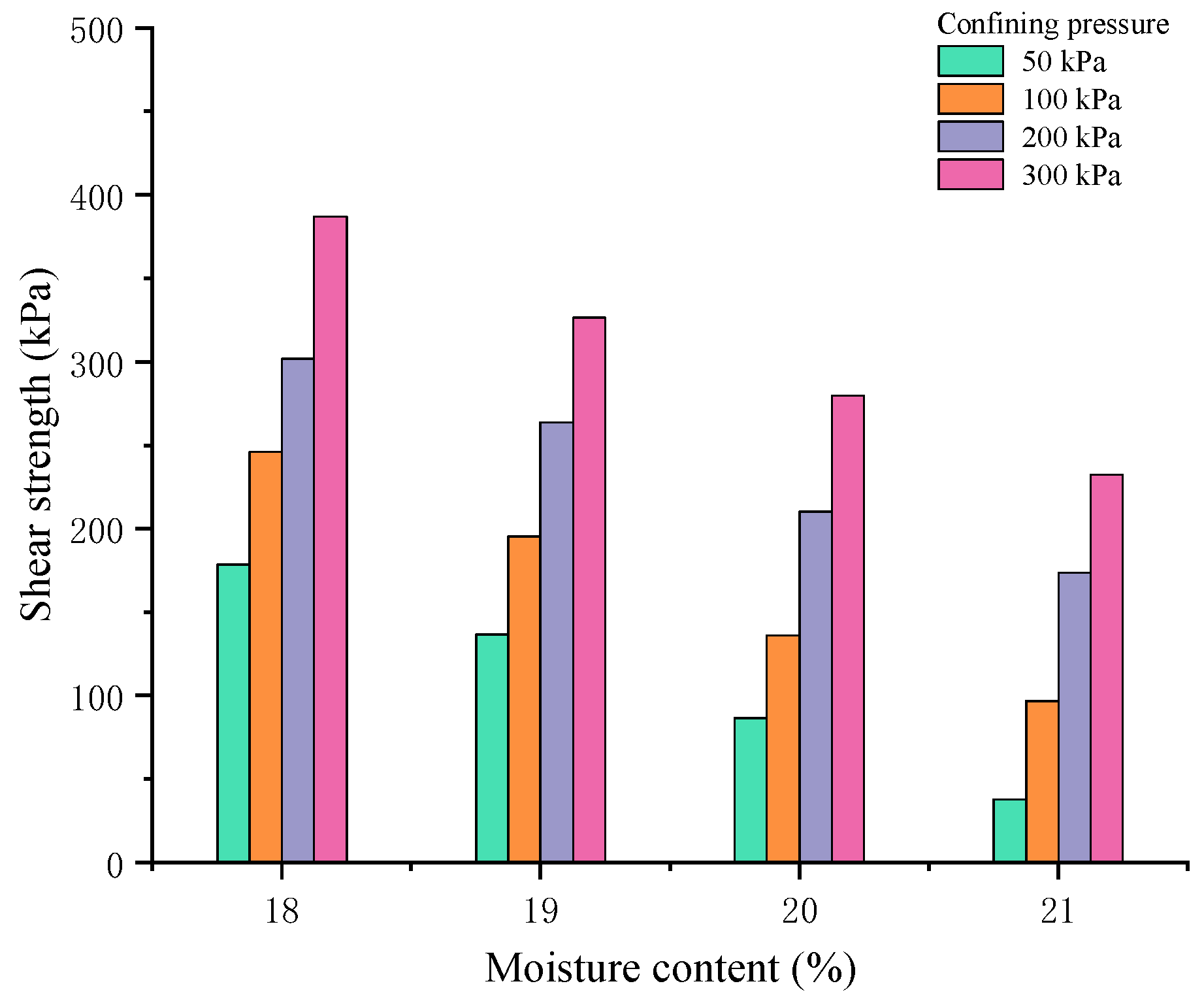
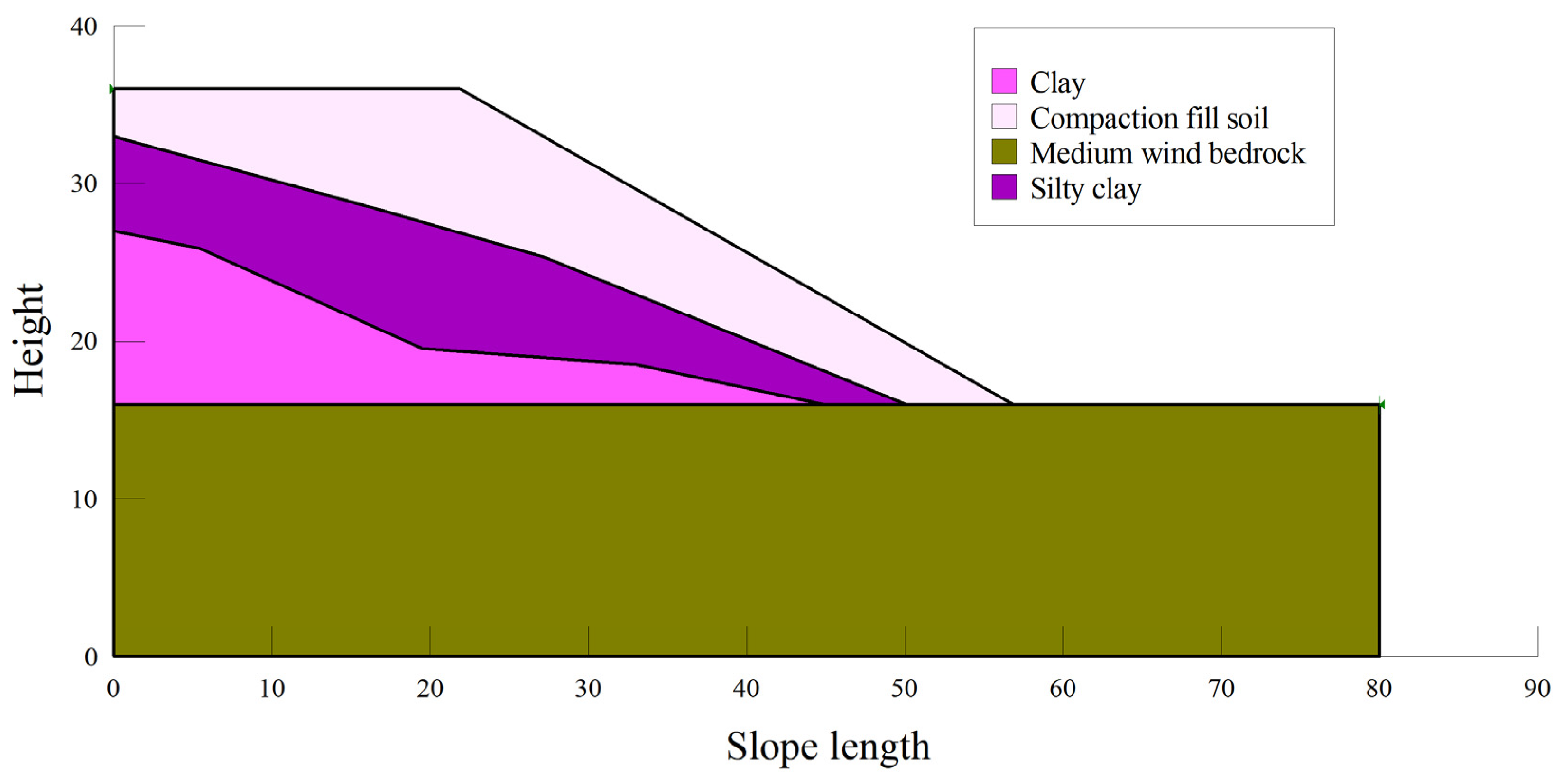

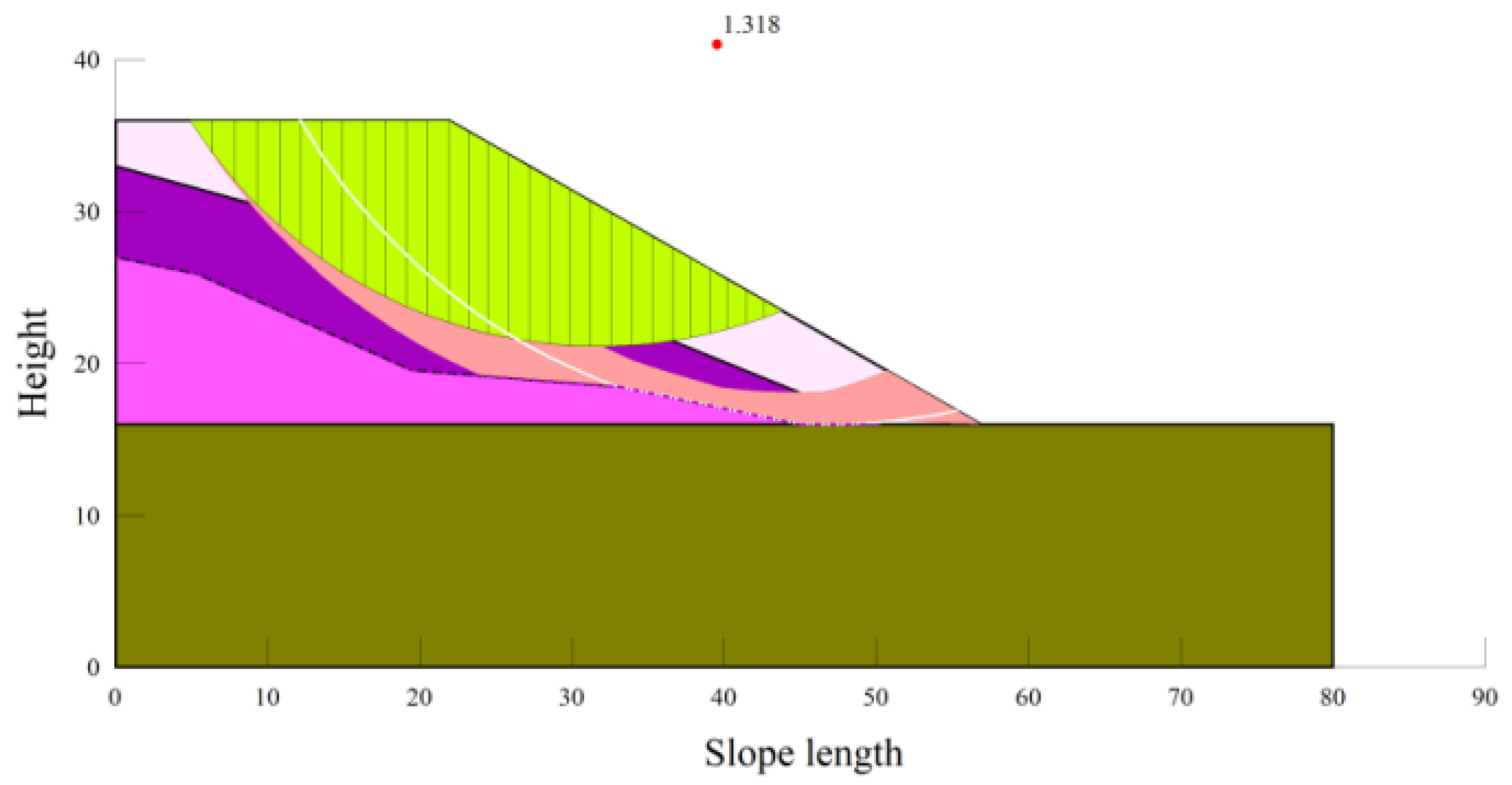
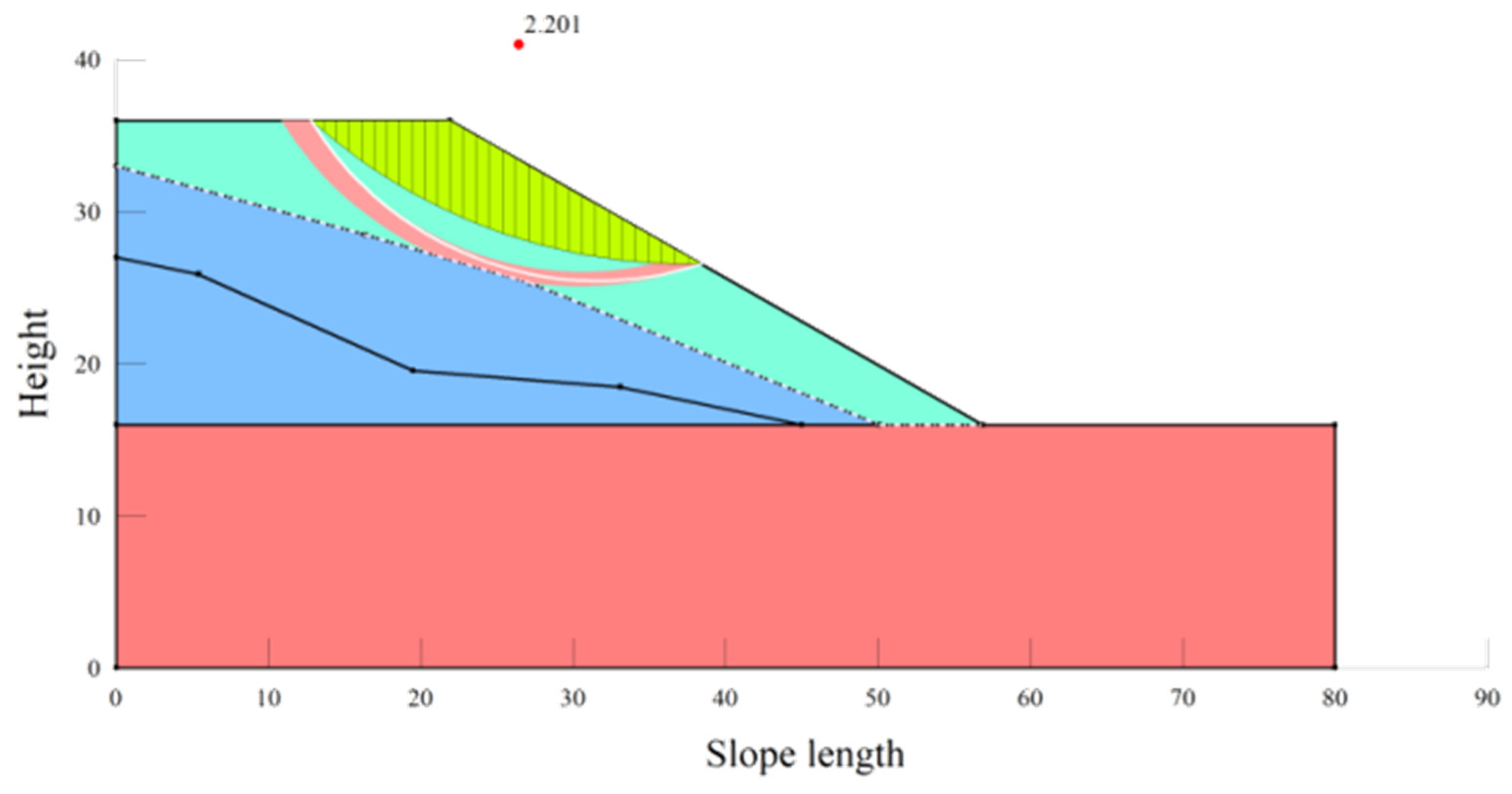


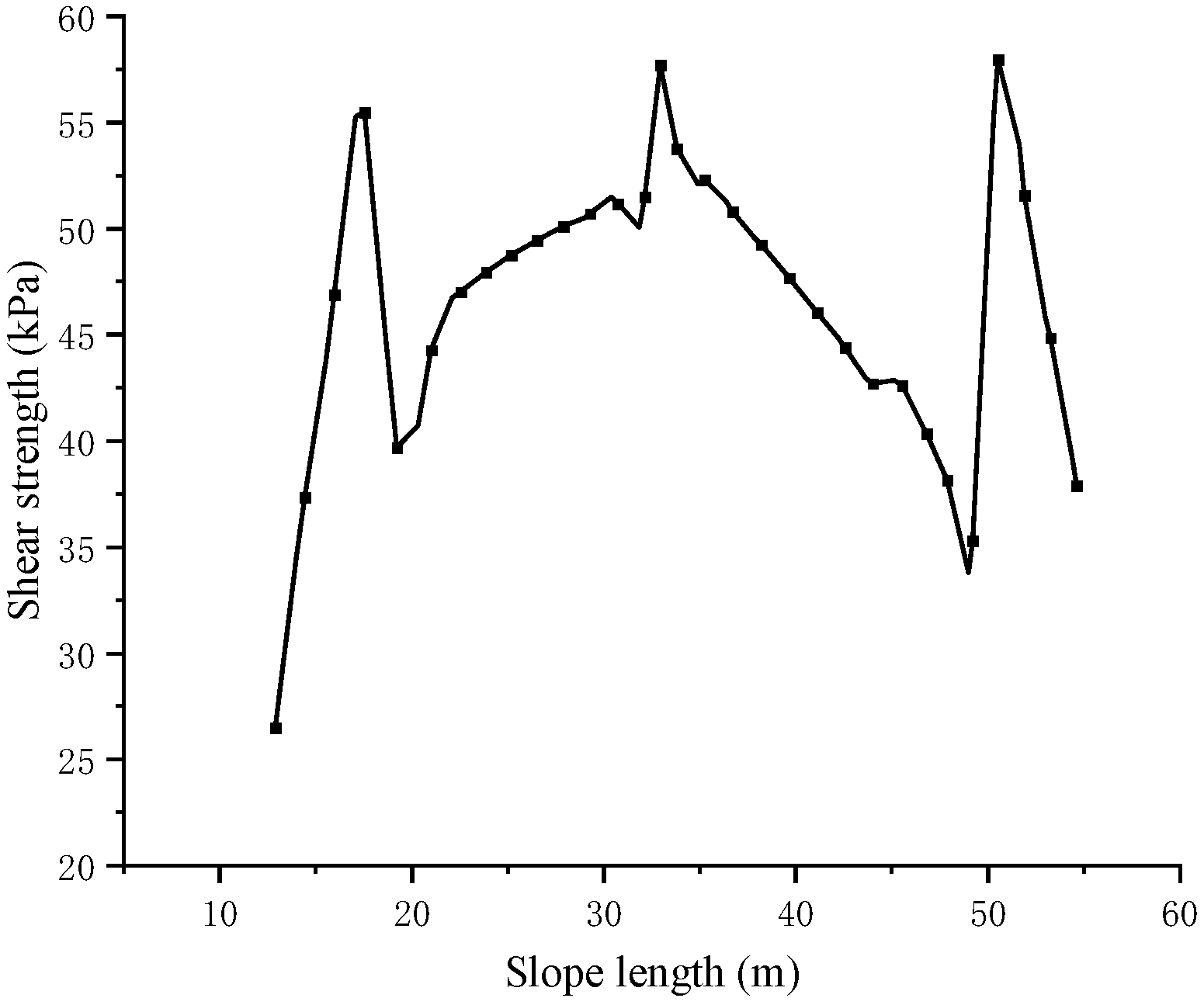


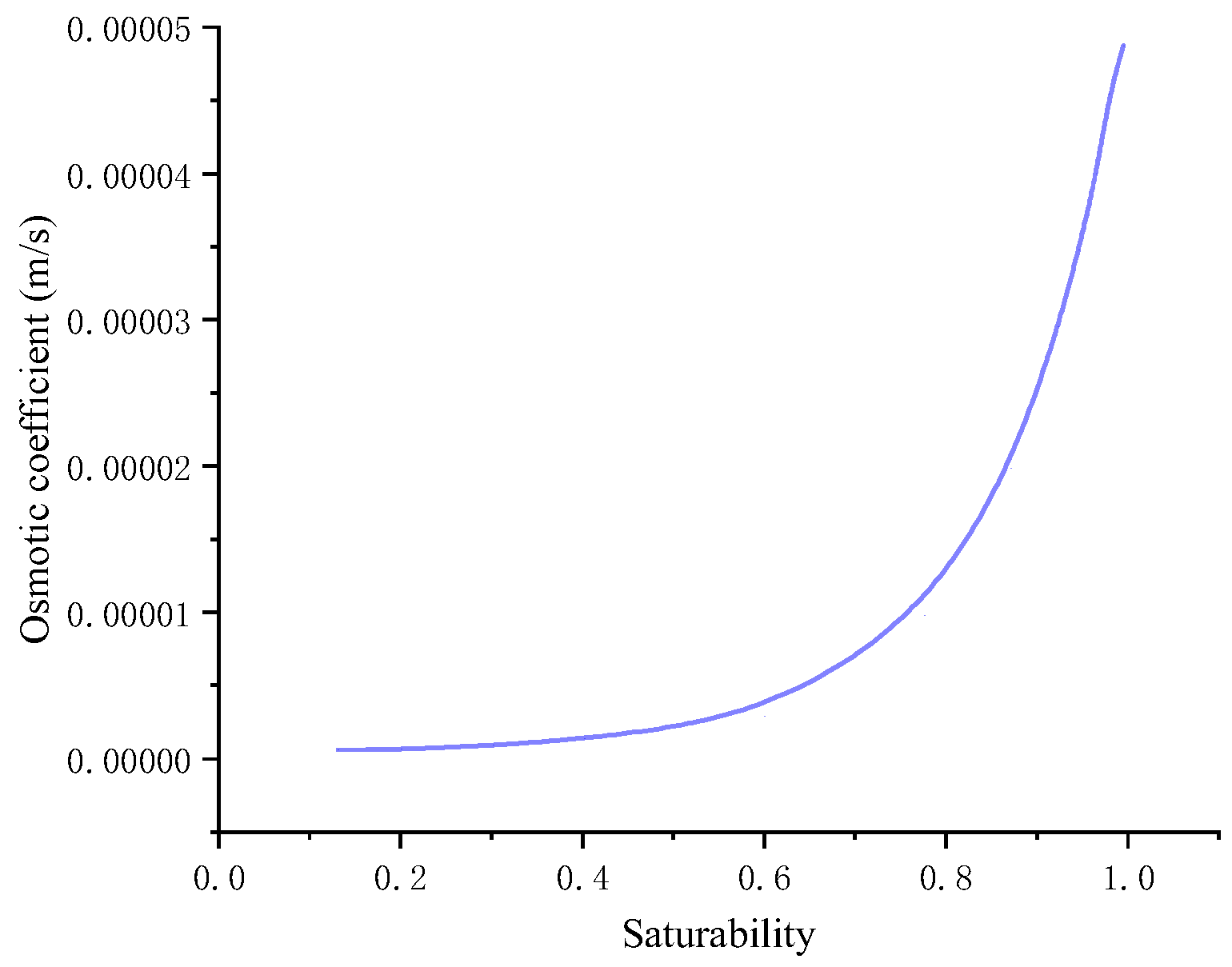

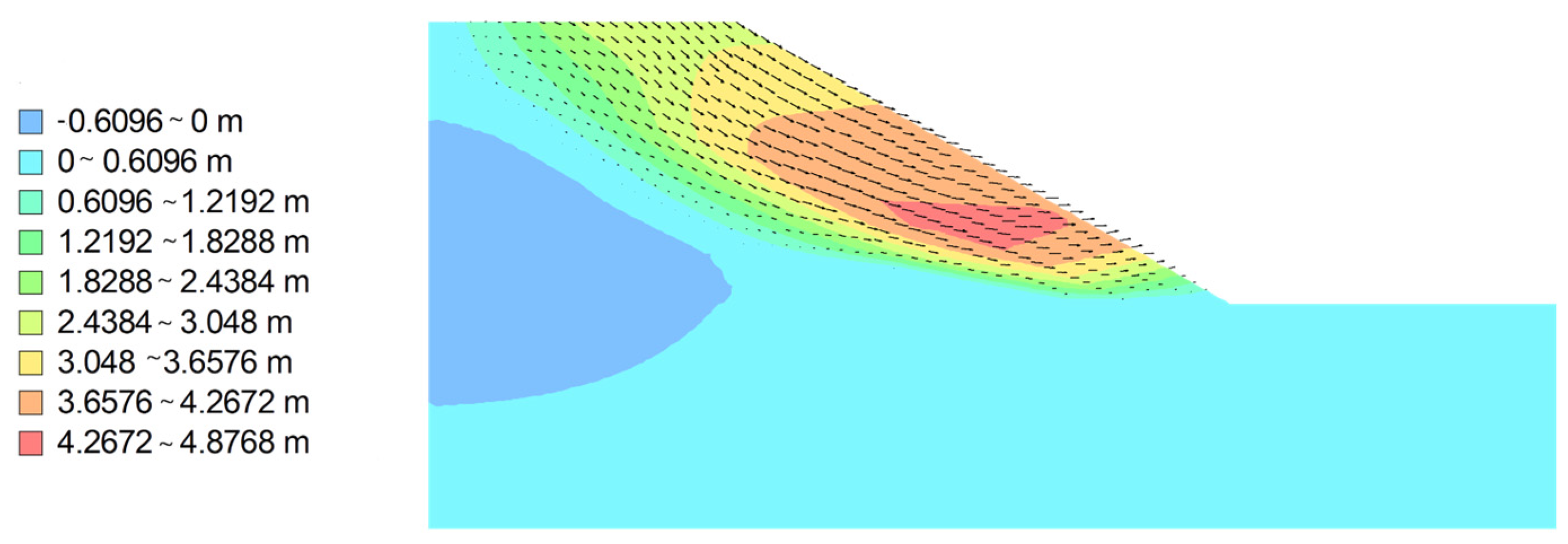
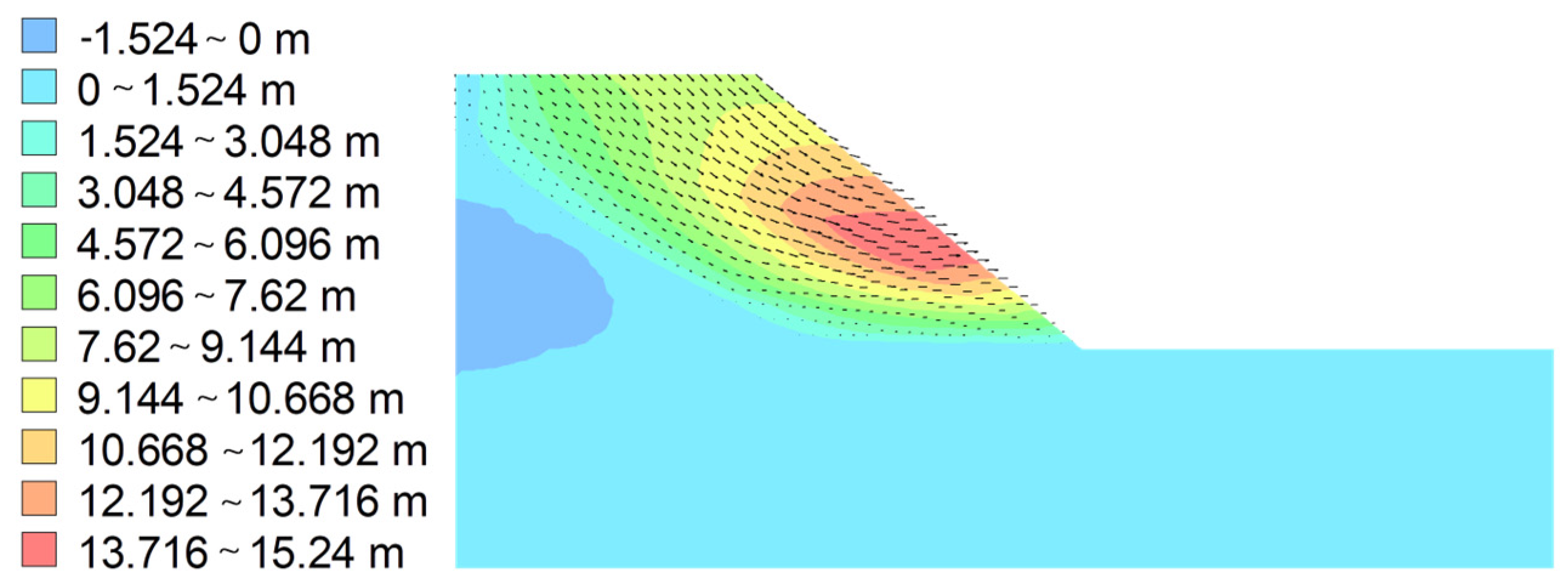
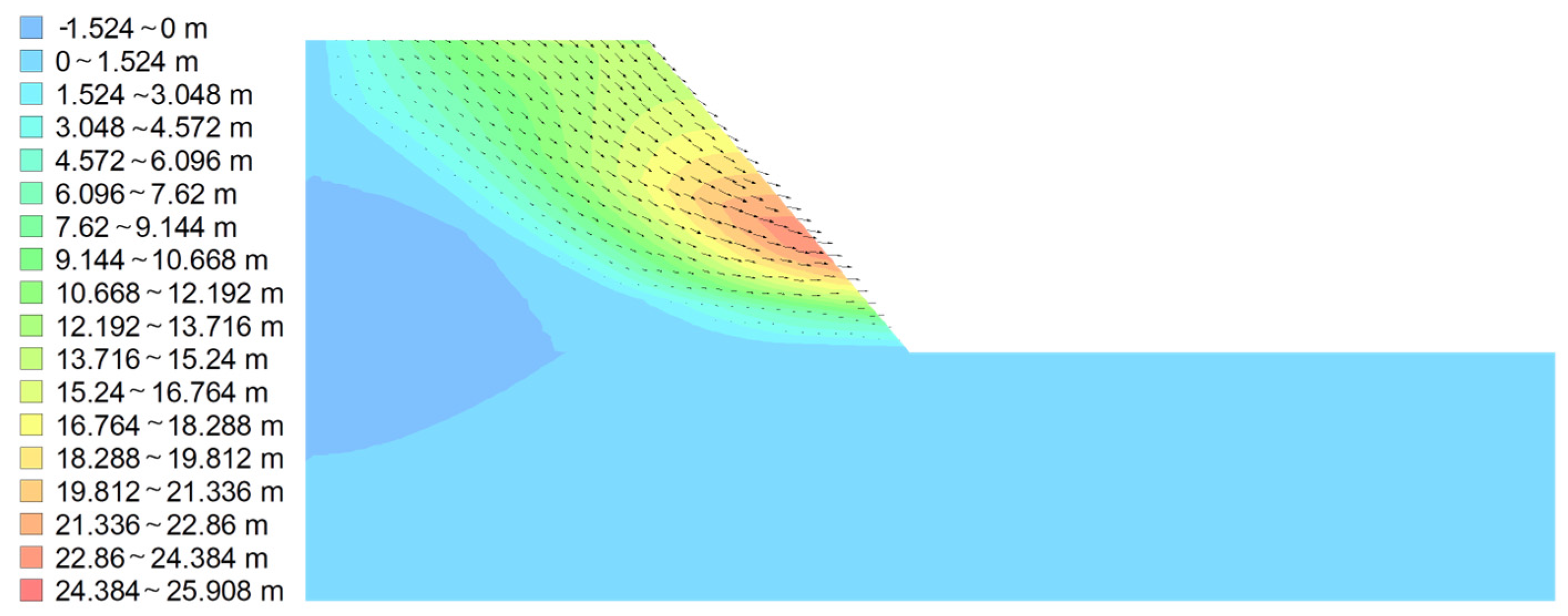
| Slope Composition | Specific Weight/(kN·m−3) | Standard Bearing Strength of Rock and Soil | Elasticity Modulus/MPa | Poisson | ||||
|---|---|---|---|---|---|---|---|---|
| Natural | Saturation | Natural | Saturation | |||||
| Internal Friction Angle φ/(°) | Cohesion C/(kPa) | Internal Friction Angle φ/(°) | Cohesion C/(kPa) | |||||
| Compaction fill soil | 19.3 | 20.5 | 19 | 35 | 16 | 32 | 15 | 0.32 |
| Silty clay | 18.5 | 19.0 | 11 | 19 | 10 | 17 | 6 | 0.30 |
| Clay | 18.6 | 19.1 | 16 | 28 | 15 | 26 | 8.6 | 0.32 |
| Medium wind bedrock | 26.0 | 26.4 | 30 | 180 | 30 | 170 | - | 0.23 |
| Month | Number of Consecutive Days of Rainfall | Maximum Rainfall (mm) |
|---|---|---|
| January | 2 | 13.2 |
| February | 3 | 16.4 |
| March | 2 | 49.6 |
| April | 5 | 88.6 |
| May | 4 | 145.7 |
| June | 6 | 216 |
| July | 6 | 164.1 |
| August | 4 | 113.8 |
| September | 2 | 75.9 |
| October | 2 | 77.2 |
| November | 1 | 50.6 |
| December | 2 | 46.7 |
Disclaimer/Publisher’s Note: The statements, opinions and data contained in all publications are solely those of the individual author(s) and contributor(s) and not of MDPI and/or the editor(s). MDPI and/or the editor(s) disclaim responsibility for any injury to people or property resulting from any ideas, methods, instructions or products referred to in the content. |
© 2024 by the authors. Licensee MDPI, Basel, Switzerland. This article is an open access article distributed under the terms and conditions of the Creative Commons Attribution (CC BY) license (https://creativecommons.org/licenses/by/4.0/).
Share and Cite
Zhang, H.; Zhang, C.; Zheng, W.; Wang, X.; Zhang, J. Analysis of the Stability of a High Fill Slope under Different Gradients and Precipitation Conditions. Appl. Sci. 2024, 14, 7590. https://doi.org/10.3390/app14177590
Zhang H, Zhang C, Zheng W, Wang X, Zhang J. Analysis of the Stability of a High Fill Slope under Different Gradients and Precipitation Conditions. Applied Sciences. 2024; 14(17):7590. https://doi.org/10.3390/app14177590
Chicago/Turabian StyleZhang, Hongda, Chengda Zhang, Weiqiang Zheng, Xiaoquan Wang, and Jiangwei Zhang. 2024. "Analysis of the Stability of a High Fill Slope under Different Gradients and Precipitation Conditions" Applied Sciences 14, no. 17: 7590. https://doi.org/10.3390/app14177590






